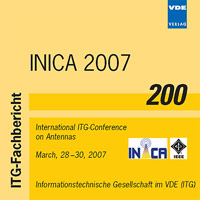Different Array Configurations and Realistic Antenna Characteristics in the Downlink of WCDMA-Based Cellular Systems
Konferenz: INICA 2007 - International ITG-Conference on Antennas
28.03.2007 - 30.03.2007 in Munich, Germany
Tagungsband: INICA 2007
Seiten: 5Sprache: EnglischTyp: PDF
Persönliche VDE-Mitglieder erhalten auf diesen Artikel 10% Rabatt
Autoren:
Bieder, Stefan; Häring, Lars; Czylwik, Andreas (University of Duisburg-Essen, Department of Communication Systems, Bismarckstr. 81, 47057 Duisburg, Germany)
Chalise, Batu K. (Université catholique de Louvain, Communication and Remote Sensing Lab., Place du Levant 2, B-1348 Louvain-La-Neuve, Belgium)
Inhalt:
The capacity of a WCDMA-based cellular system like a UMTS-FDD network can be highly improved by utilizing the smart antenna concept. The amount of interference power in the entire network can be reduced by employing antenna arrays at the base station side and performing beamforming. The number of antenna elements as well as the characteristics of the single antenna element have a strong influence on the amount of achievable capacity improvement. Therefore, close-to-reality investigations on the network capacity must incorporate realistic antenna element characteristics. In this contribution, a UMTS-FDD network equipped with smart antennas at the base stations is analysed on system level to gain insight on the effect of different realistic antenna and array characteristics on the network capacity. For investigations on system level, the limitation of available resources of the cellular network has to be included into the analysis. For this purpose, different types of antenna elements like dipoles and commercially available real-world base station antennas for UMTS are compared for different array topologies in scenarios with and without code limitation.


